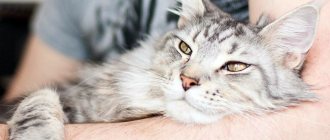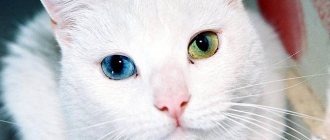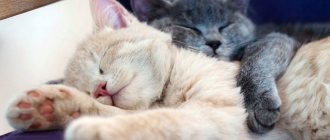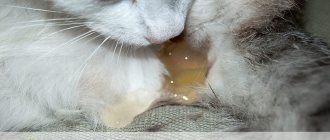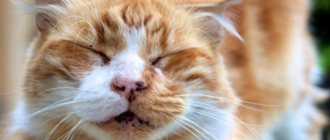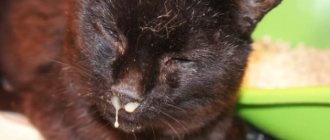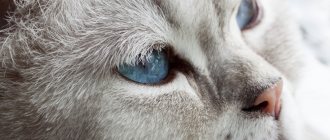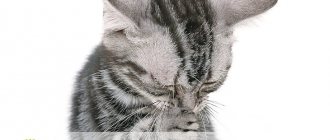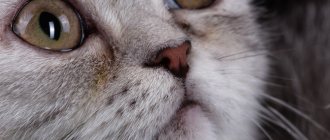The cat suddenly has a nosebleed, droplets appear when sneezing, or constant discharge from one or both nostrils.
In most cases, bleeding stops on its own.
What to do if it doesn't stop?
Firstly, as one famous fairy tale character said: “Calm, only calm!” When cats are excited, their blood pressure increases, which leads to increased bleeding. Try to calm your pet. Do not panic yourself, since the owner’s nervous excitement is transmitted to the animal.
Second, to constrict the blood vessels, place a cold compress (such as an ice pack) on the back of your cat's nose and hold it with gentle pressure so as not to impede breathing.
Once the bleeding has stopped, very carefully use a paper towel and water to clean your cat's nose as much as possible.
If the bleeding does not stop, or you notice other symptoms in your pet, such as breathing problems, contact your veterinarian immediately.
Causes and types of bleeding
A cat's nose may bleed for many reasons. In order to detect them, it is necessary to observe the animal for other symptoms of any disease.
Nosebleeds can be divided into types according to severity:
- Acute – begins suddenly and asymptomatically;
- Chronic – you can systematically notice bloody discharge under the cat’s nose.
Also, bleeding can be bilateral or unilateral. As a rule, they arise for various reasons. To diagnose the disease, it is very important to immediately determine, after the first symptoms of bleeding appear, whether blood is flowing from one nostril or from both. Unilateral bleeding usually indicates the presence of a foreign body, tumor or injury in the nose, while bilateral bleeding usually indicates an infectious disease.
Some cats have an individual tendency to bleed, but such cases are very rare. Most often, this problem is caused by a specific cause that requires urgent medical intervention.
Causes of bleeding:
- Getting injured or bruised as a result of fights and blows that lead to severe swelling;
- Foreign bodies in the animal's nose;
- The presence of cancer and infectious diseases, or diseases of the circulatory system;
- Having problems with teeth;
- Parasites in the nasal cavity;
- Ingress of rat poison into the cat’s body;
- Blood pressure problems;
- Reaction to the use of certain medications;
- The presence of purulent or fungal lesions of the cat’s nasal cavity;
- Consequences of heat stroke.
In some cases, a cat may sneeze and sneeze. Therefore, you need to monitor your pet very carefully so as not to miss this important symptom. You also need to carefully examine the cat's oral cavity: perhaps blood is flowing as a result of damage to the tooth root after a strong collision with a bicycle or car.
A cat sneezes: the reasons for this phenomenon
An animal may sneeze for natural reasons, for example, a speck of dust has entered its nasal passages.
But there are also reasons why owners should really think about it. Let's list them.
A cat may sneeze due to:
- polyps inside the nose;
- colds;
- presence of allergies;
- cancer of the nasal cavity;
- problems with gums or teeth;
- sinus infections.
Why does a cat sneeze? If this happens all the time, then this indicates the presence of an infection that is located in the upper respiratory tract. This may be a herpes virus, parainfluenza virus or adenovirus.
The first named infection takes a very long time to be treated, complicated by exacerbations.
In addition, the cat, like any creature, is susceptible to allergic irritants.
These include substances such as:
- tobacco smoke;
- pollen;
- insect sprays;
- perfume;
- mold;
- cleaning (household) products.
Upon contact with an allergen, the purr immediately begins to sneeze
Particular attention should be paid to cats with a flat nose, for example, Persian. Breeds with short nasal passages are primarily susceptible to irritants
What is the danger of nosebleeds?
In some cases, the presence of bloody discharge from a cat's nostrils requires emergency veterinary attention. As a rule, this is indicated by additional symptoms. Therefore, it is worth examining the animal as soon as bloody discharge from the nose appears.
Signs that accompany a nosebleed and indicate the need to take your cat to a veterinarian:
- When you sneeze, a lot of blood is released;
- There is deformation of the muzzle, swelling on the animal’s body;
- The mucous membrane of the oral cavity acquires a marble color;
- Presence of symptoms of periodontal disease or gumboil;
- The animal's feces become black, acquiring a viscous consistency. This indicates that some of the blood is going inward rather than flowing outward. In such a situation, urgent diagnosis is necessary;
- The presence of an unpleasant odor from the mouth and nose;
- Difficulty breathing;
- The animal sleeps a lot;
- Loss of appetite.
If you have such symptoms, you should contact a specialist for examination and further diagnosis.
Signs
The clinical picture may include:
- nosebleeds;
- swelling of the nose;
- sneezing, splashing blood;
- noisy breathing;
- anxiety;
- odor from the nasal and oral cavity;
- loss of appetite;
- lethargy;
- black stools (caused by ingestion and digestion of blood).
If you notice bleeding from the nasal passages, you should carefully examine your cat. In the case of systemic pathologies (for example, rodenticide poisoning), other signs of bleeding disorders appear: multiple small hemorrhages on the skin (capillary lesions - petechiae), bleeding gums, vomiting with blood, dark stool, stool mixed with blood, etc.
It is also important to understand whether the blood is flowing from one nostril or from both at the same time. This will allow a more accurate preliminary diagnosis.
First aid for nosebleeds in animals
Having noticed that the pet is bleeding from the nose, the owner must calm down himself, and then carefully examine the animal to determine the degree of complexity of the situation. After this, it is necessary to calm the animal to avoid an increase in blood pressure. There is no need to give sedatives or other medications without consulting a veterinarian.
In case of severe bleeding, you need to apply a cooling compress by applying ice to the animal’s nose. If your cat does not get better over time, you should immediately consult a doctor.
First aid for a cat with a nosebleed
So, the cat has blood coming out of its nose. If a runny nose initially occurs and streaks of blood appear in the mucus, this condition is most likely not critical, although it also requires certain actions (more about this in the article “What to do when a cat sneezes and has snot?”).
The release of drops, and even more so a trickle of blood, can seriously frighten the owner. What to do if your cat has a bleeding nose? First of all, put off panic. The owner's anxiety can agitate the pet, and this will lead to increased blood pressure and, as a result, increased bleeding.
Try to calm down: now the health of your beloved animal depends on your composure. Provide your pet with silence and a calm environment.
If moderate to severe nosebleeds develop, it is better to adhere to the following algorithm of actions:
- Apply something cold to the bridge of your nose, such as an ice pack or something wrapped in a cloth from the freezer. This must be done in such a way as not to prevent the animal from breathing freely.
- Find out where the nearest veterinary clinic equipped with a rhinoscope is located. If there is no one nearby, then go to any other one or call a veterinarian at home.
- While you are waiting for a doctor's examination, if possible, carefully examine the animal yourself - its face and mouth. Remember what medications you gave the cat, whether there was access to the street, etc. If the animal feels unwell, has pale mucous membranes and rapid breathing, and the bleeding continues, then the clinic can see you without a queue.
If veterinary care is not available, cold treatment should be applied until the bleeding subsides. You can gently rinse your nose with aminocaproic acid - this is a hemostatic agent sold in a regular pharmacy. We talked in detail about the technique of rinsing the nose of cats in the article “What to do at home if a cat sneezes?”
Unfortunately, it is impossible to determine the exact causes at home - only a specialist can do this.
Diagnostics
In order to find out why a cat’s nose is bleeding, the veterinarian prescribes a comprehensive examination of the animal.
Diagnostic methods:
- Tests are performed: general or biochemical blood test, coagulation test, endoscopy, biopsy, cytology, x-ray examination of the nasal cavity;
- A careful visual examination, examination of the nasal as well as oral tracts, mouth, lower nostrils, throat.
- Urinalysis to assess liver function;
- Serological tests are carried out for the presence of fungal diseases, as well as infections caused by ticks;
- Carrying out computed tomography, magnetic resonance imaging;
- Rhinoscopy;
- Blood pressure measurement;
- Surgery for residual diagnosis.
The need for a specific diagnostic method is determined by the veterinarian depending on the complexity of the symptoms. After the diagnosis is established, treatment is prescribed to eliminate the bleeding, as well as the reasons that caused it.
My cat sneezes and snorts. What's the matter? General information
Sneezing and snorting seem like obvious enough signs to identify, but it's not always easy to tell them apart in pets. Indeed, these two symptoms can sometimes appear so that many people use the terms interchangeably. Sneezing is usually defined as a sudden, involuntary movement of air from the lungs through the nose and mouth. This phenomenon usually occurs in response to some irritant of the upper respiratory tract, most often to the thin receptor structures of the mucous membrane that lines the nasal passages.
A snort, on the other hand, looks and is identically defined as a sneeze. The difference is that sneezing is involuntary, while snorting is a voluntary effort on the part of the pet.
Dogs and cats sneeze and snort for a variety of reasons related to the functioning of the upper respiratory tract. While many are normal and benign reactions to simple irritation, some may signal infections, upper airway obstructions, and allergic diseases. There are also other pathological conditions of the upper respiratory tract.
Rhinitis in cats
A runny nose in cats is most often caused by a cold. Rhinitis can also be the result of an allergy - to dust, perfume, air freshener or other household chemicals. If rhinitis is not treated, it becomes chronic - then it is dangerous due to the growth of polyps and adenoids. How can you tell if a cat’s runny nose is due to an allergy? The discharge is watery, sneezing is frequent. If there is an infection, the discharge becomes colored, becomes viscous and has a specific odor.
With rhinitis, a cat's nose becomes red, especially the edges of the nostrils, wheezing is heard when breathing, and with infections - lacrimation and the formation of crusts under the eyes.
Why might a cat sneeze?
There are different reasons why a cat sneezes. The most common ones are:
- Trivial dust getting into your nose. When a kitten sneezes once, then nothing should be done, but if the situation drags on, then you can check the pet’s nose and mouth to see if any specks or lint are stuck there.
- Allergic reaction to strong odors. If your pet sneezes frequently, it may have an allergy. Cats have a developed sense of smell, so conditions such as allergies are not uncommon for them. Most often, intolerance develops to tobacco smoke, household perfume, and plant pollen. Often, due to an allergic reaction, the pet’s eyes water and he coughs. In this case, consultation with a veterinarian and appropriate treatment are necessary.
- Viral disease. When communicating with other animals, it is possible to become infected with viruses, which is why the kitten sneezes and coughs frequently. If it’s a matter of viruses and bacteria, then these signs include snot, fever, watery eyes, lack of appetite, and the pet becomes lethargic.
- Toxoplasmosis. You can suspect such a complex disease when kittens have difficulty breathing.
- Chlamydia. Sometimes the onset of the disease begins with the appearance of sneezing.
- Bortedellosis occurs in both adult pets and kittens. The animal begins to sneeze frequently, it coughs, its eyes become watery and purulent, and difficulty breathing appears.
- Mycoplasmosis. In this case, the eyes not only water, but also fester. The pet develops snot and coughs.
- Helminths or fleas, or rather the products of their excretion, can cause a similar reaction in a pet; anthelmintic drugs and flea remedies: shampoos, drops, collars will help treat this condition.
A pregnant woman should be protected from a kitten with toxoplasmosis, because the disease can be transmitted to the fetus, which may develop various malformations.


